Engine ecu SSANGYONG NEW ACTYON SPORTS 2013 Workshop Manual
[x] Cancel search | Manufacturer: SSANGYONG, Model Year: 2013, Model line: NEW ACTYON SPORTS, Model: SSANGYONG NEW ACTYON SPORTS 2013Pages: 751, PDF Size: 72.63 MB
Page 377 of 751

03-57010-06
Item Front view Rear view Internal structure
RKSTICS key
2. OVERVIEW
The Immobilizer System provides an additional theft deterrent to the vehicle in which it is installed and
prevents it from being started by unauthorized persons. The transponder integrated in the key and the
engine control unit has the same code. When the ignition key with the integrated transponder is turned to
the ON position, the ECU (Engine Control Unit) checks the crypto code of the key and, if correct, allows
your vehicle to start the engine.
Immobilizer unit
RKSTICS Key ▶
Page 380 of 751
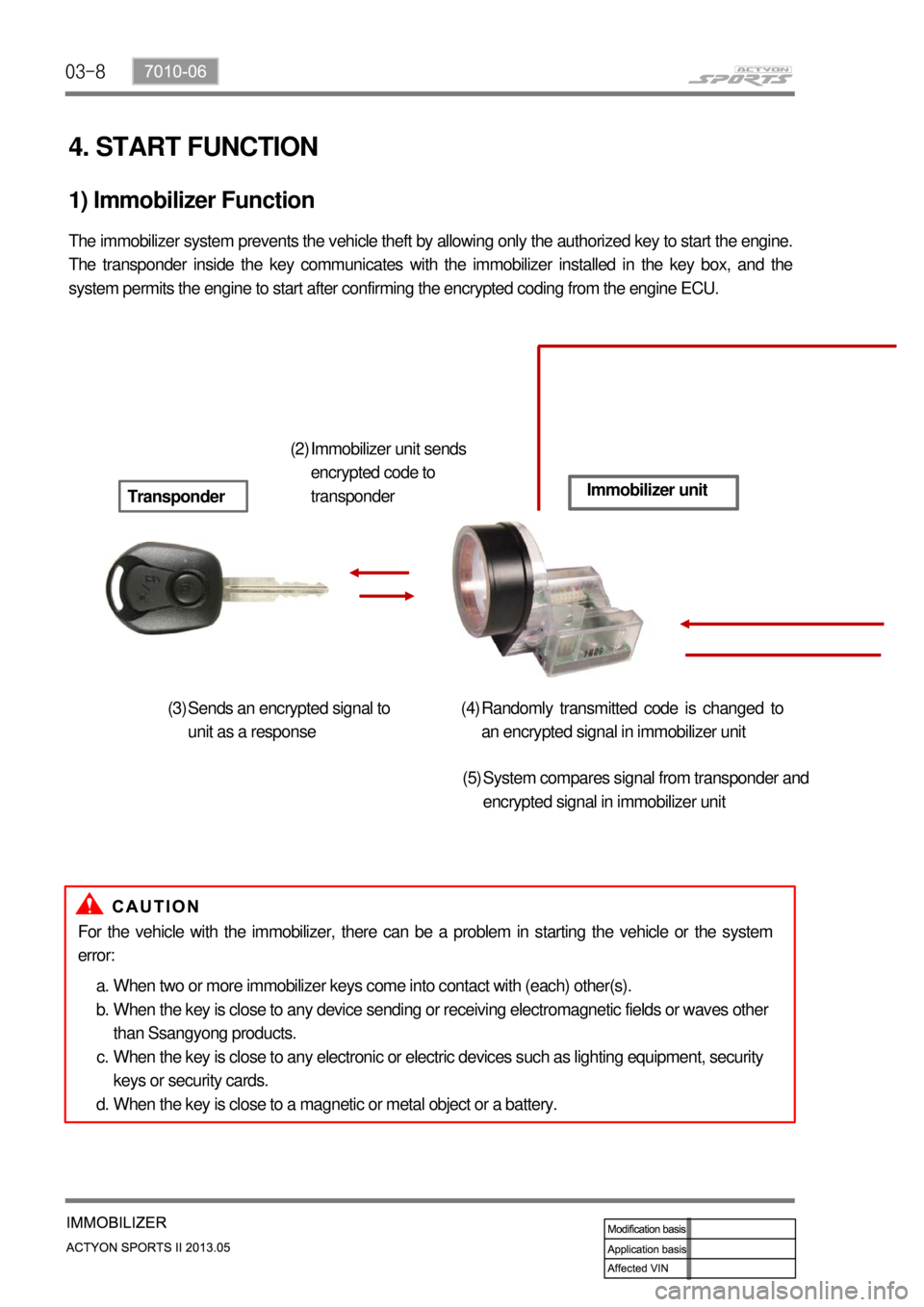
03-8
4. START FUNCTION
1) Immobilizer Function
The immobilizer system prevents the vehicle theft by allowing only the authorized key to start the engine.
The transponder inside the key communicates with the immobilizer installed in the key box, and the
system permits the engine to start after confirming the encrypted coding from the engine ECU.
For the vehicle with the immobilizer, there can be a problem in starting the vehicle or the system
error:Immobilizer unit sends
encrypted code to
transponder (2)
Sends an encrypted signal to
unit as a response (3) Randomly transmitted code is changed to
an encrypted signal in immobilizer unit (4)
System compares signal from transponder and
encrypted signal in immobilizer unit (5)
When two or more immobilizer keys come into contact with (each) other(s).
When the key is close to any device sending or receiving electromagnetic fields or waves other
than Ssangyong products.
When the key is close to any electronic or electric devices such as lighting equipment, security
keys or security cards.
When the key is close to a magnetic or metal object or a battery. a.
b.
c.
d.
Immobilizer unitTransponder
Page 381 of 751
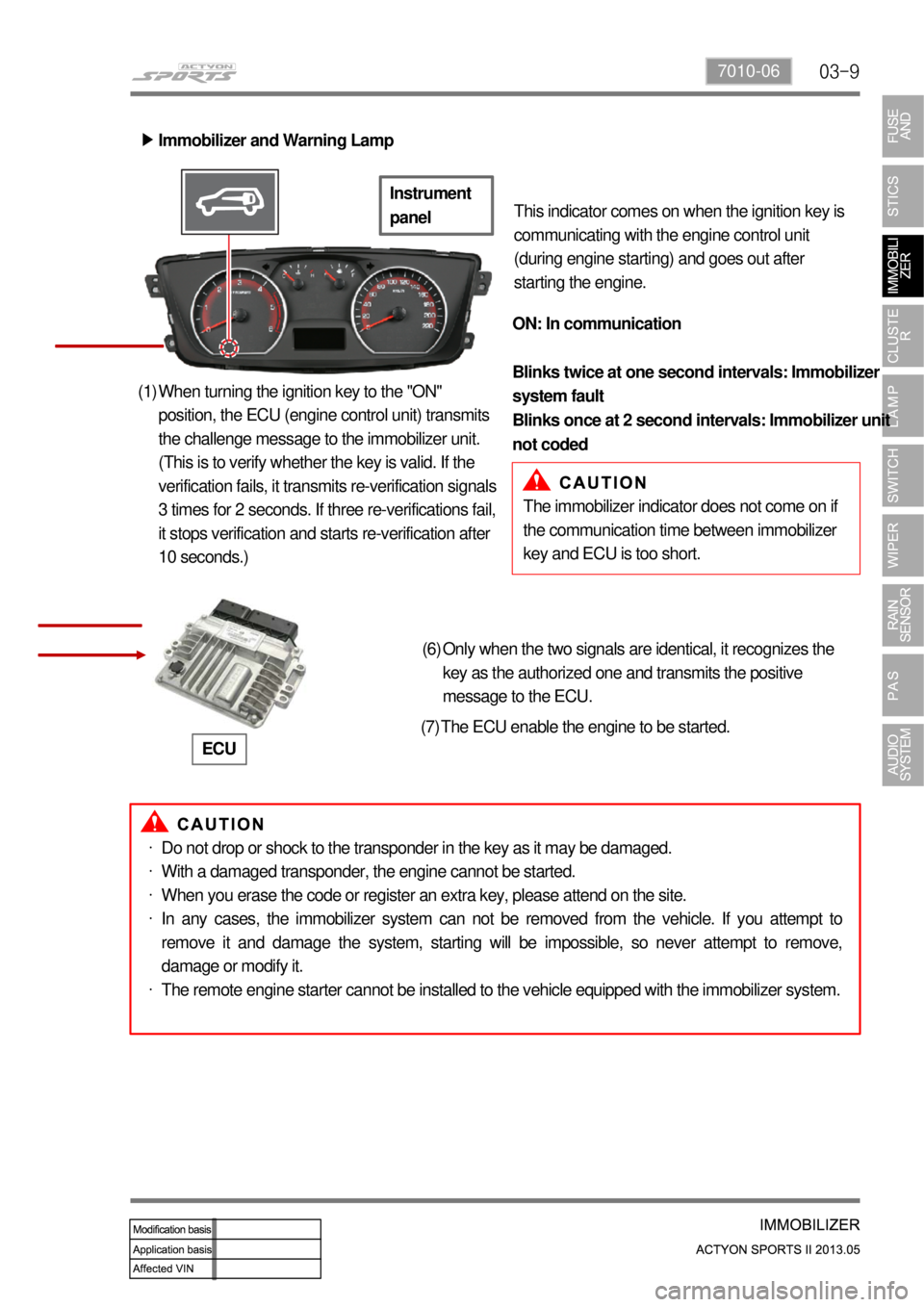
03-97010-06
Immobilizer and Warning Lamp ▶
This indicator comes on when the ignition key is
communicating with the engine control unit
(during engine starting) and goes out after
starting the engine.
When turning the ignition key to the "ON"
position, the ECU (engine control unit) transmits
the challenge message to the immobilizer unit.
(This is to verify whether the key is valid. If the
verification fails, it transmits re-verification signals
3 times for 2 seconds. If three re-verifications fail,
it stops verification and starts re-verification after
10 seconds.) (1)
ECUOnly when the two signals are identical, it recognizes the
key as the authorized one and transmits the positive
message to the ECU. (6)
The ECU enable the engine to be started. (7)
Do not drop or shock to the transponder in the key as it may be damaged.
With a damaged transponder, the engine cannot be started.
When you erase the code or register an extra key, please attend on the site.
In any cases, the immobilizer system can not be removed from the vehicle. If you attempt to
remove it and damage the system, starting will be impossible, so never attempt to remove,
damage or modify it.
The remote engine starter cannot be installed to the vehicle equipped with the immobilizer system. ·
·
·
·
·ON: In communication
Blinks twice at one second intervals: Immobilizer
system fault
Blinks once at 2 second intervals: Immobilizer unit
not coded
The immobilizer indicator does not come on if
the communication time between immobilizer
key and ECU is too short.
Instrument
panel
Page 403 of 751
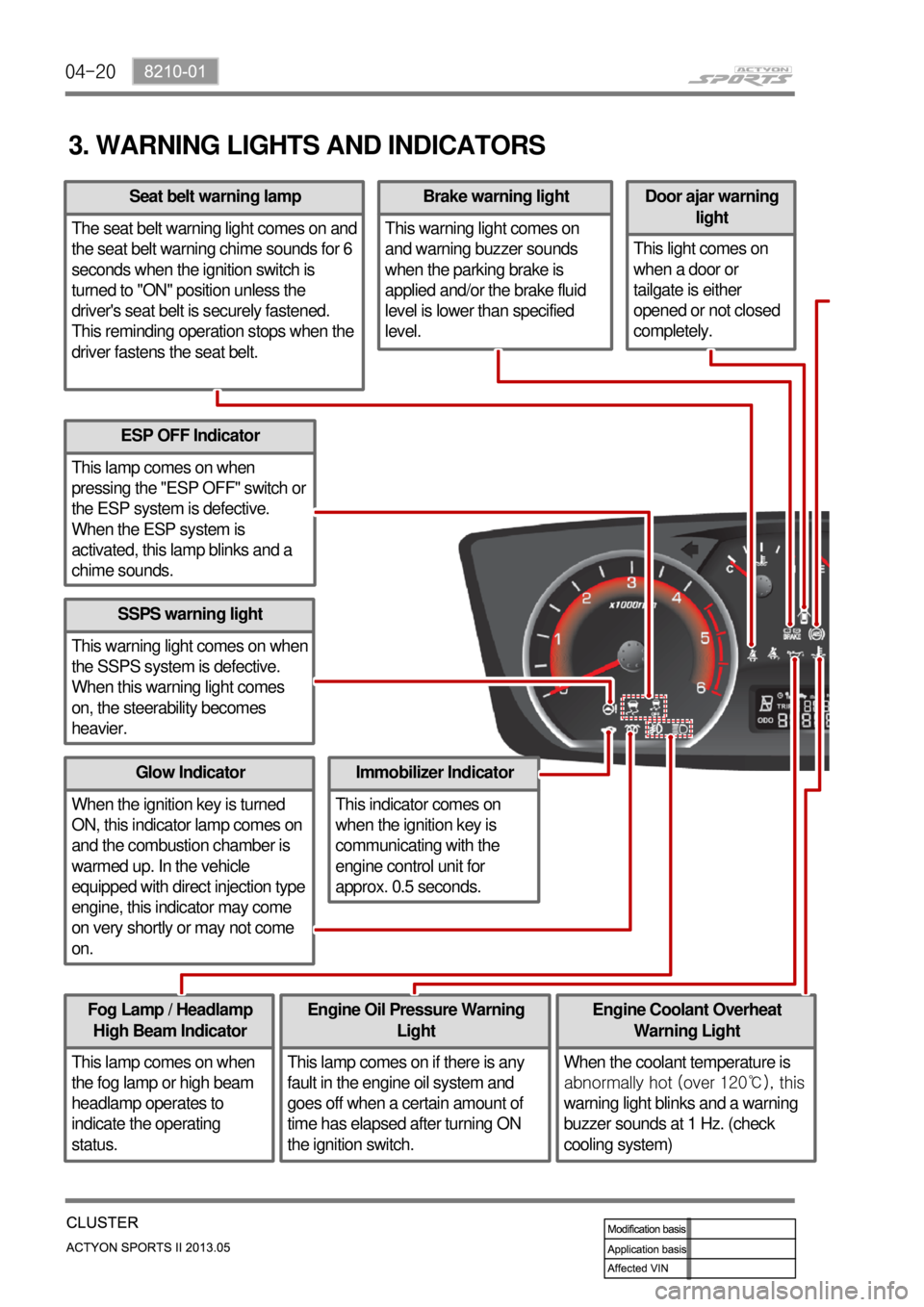
04-20
3. WARNING LIGHTS AND INDICATORS
ESP OFF Indicator
This lamp comes on when
pressing the "ESP OFF" switch or
the ESP system is defective.
When the ESP system is
activated, this lamp blinks and a
chime sounds.
Immobilizer Indicator
This indicator comes on
when the ignition key is
communicating with the
engine control unit for
approx. 0.5 seconds.Glow Indicator
When the ignition key is turned
ON, this indicator lamp comes on
and the combustion chamber is
warmed up. In the vehicle
equipped with direct injection type
engine, this indicator may come
on very shortly or may not come
on.
Fog Lamp / Headlamp
High Beam Indicator
This lamp comes on when
the fog lamp or high beam
headlamp operates to
indicate the operating
status.Engine Oil Pressure Warning
Light
This lamp comes on if there is any
fault in the engine oil system and
goes off when a certain amount of
time has elapsed after turning ON
the ignition switch.
Door ajar warning
light
This light comes on
when a door or
tailgate is either
opened or not closed
completely.Brake warning light
This warning light comes on
and warning buzzer sounds
when the parking brake is
applied and/or the brake fluid
level is lower than specified
level.Seat belt warning lamp
The seat belt warning light comes on and
the seat belt warning chime sounds for 6
seconds when the ignition switch is
turned to "ON" position unless the
driver's seat belt is securely fastened.
This reminding operation stops when the
driver fastens the seat belt.
Engine Coolant Overheat
Warning Light
When the coolant temperature is
abnormally hot (over 120℃), this
warning light blinks and a warning
buzzer sounds at 1 Hz. (check
cooling system)
SSPS warning light
This warning light comes on when
the SSPS system is defective.
When this warning light comes
on, the steerability becomes
heavier.
Page 419 of 751
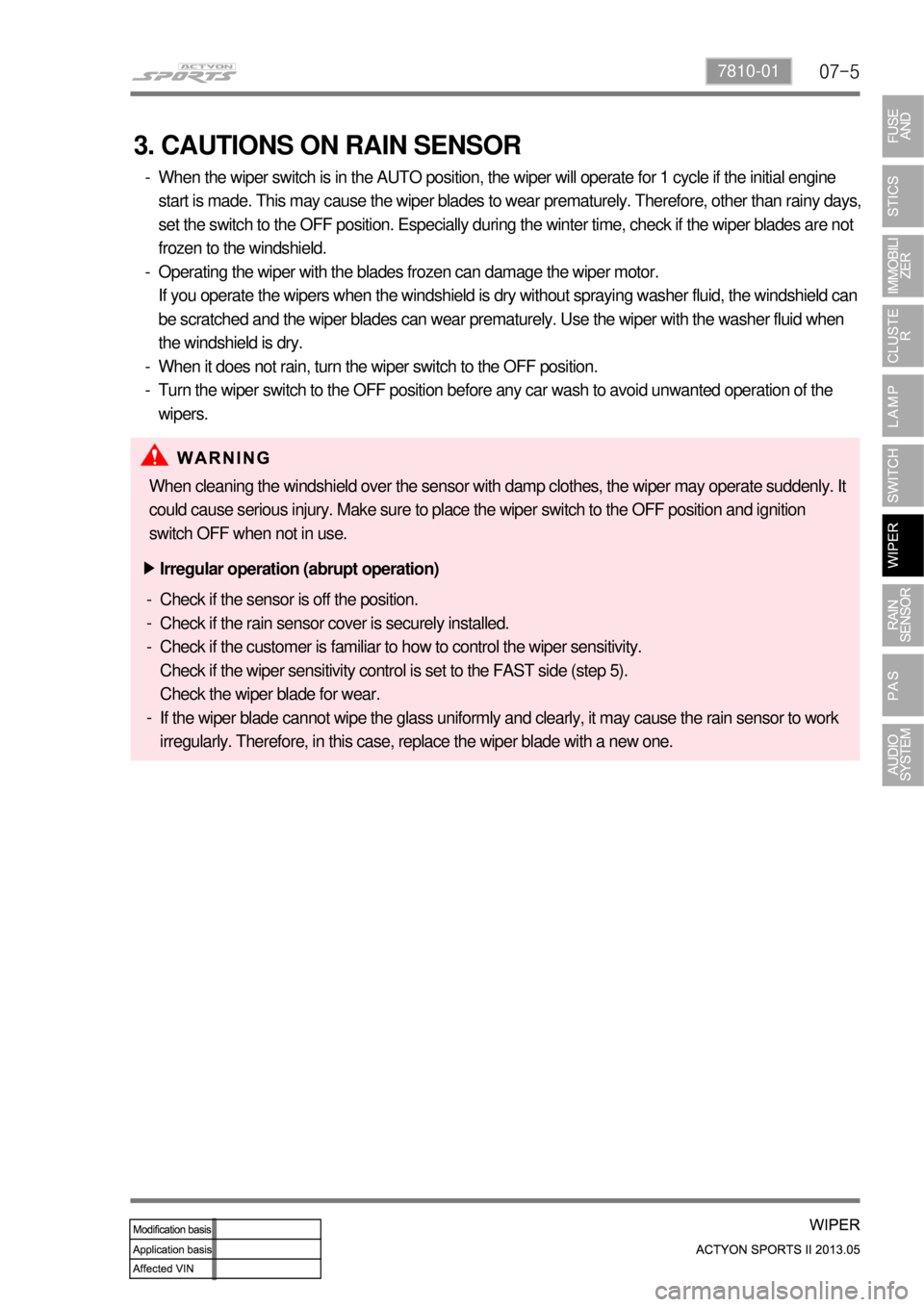
07-57810-01
3. CAUTIONS ON RAIN SENSOR
When the wiper switch is in the AUTO position, the wiper will operate for 1 cycle if the initial engine
start is made. This may cause the wiper blades to wear prematurely. Therefore, other than rainy days,
set the switch to the OFF position. Especially during the winter time, check if the wiper blades are not
frozen to the windshield.
Operating the wiper with the blades frozen can damage the wiper motor.
If you operate the wipers when the windshield is dry without spraying washer fluid, the windshield can
be scratched and the wiper blades can wear prematurely. Use the wiper with the washer fluid when
the windshield is dry.
When it does not rain, turn the wiper switch to the OFF position.
Turn the wiper switch to the OFF position before any car wash to avoid unwanted operation of the
wipers. -
-
-
-
When cleaning the windshield over the sensor with damp clothes, the wiper may operate suddenly. It
could cause serious injury. Make sure to place the wiper switch to the OFF position and ignition
switch OFF when not in use.
Irregular operation (abrupt operation) ▶
Check if the sensor is off the position.
Check if the rain sensor cover is securely installed.
Check if the customer is familiar to how to control the wiper sensitivity.
Check if the wiper sensitivity control is set to the FAST side (step 5).
Check the wiper blade for wear.
If the wiper blade cannot wipe the glass uniformly and clearly, it may cause the rain sensor to work
irregularly. Therefore, in this case, replace the wiper blade with a new one. -
-
-
-
Page 449 of 751
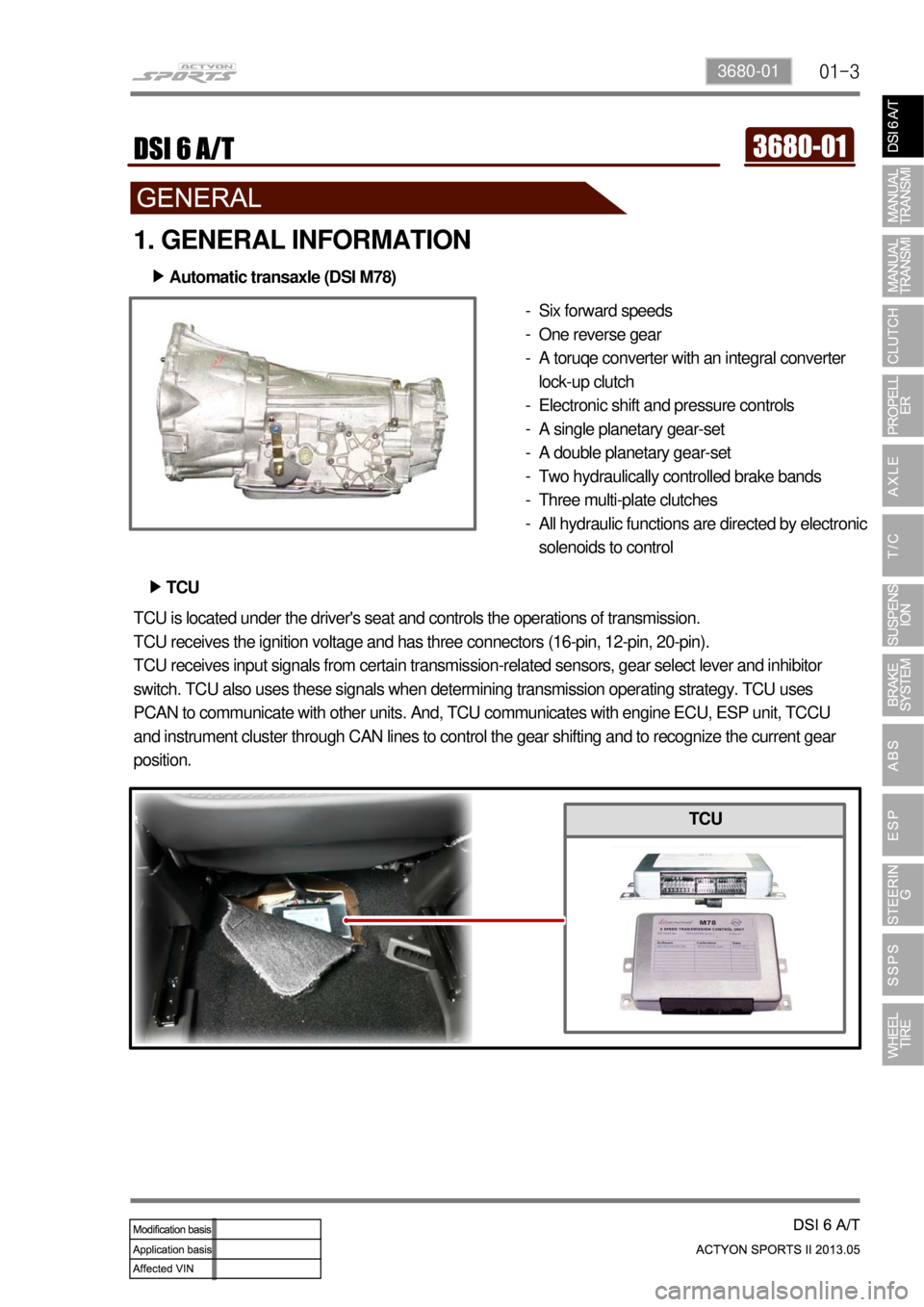
01-33680-01
1. GENERAL INFORMATION
Six forward speeds
One reverse gear
A toruqe converter with an integral converter
lock-up clutch
Electronic shift and pressure controls
A single planetary gear-set
A double planetary gear-set
Two hydraulically controlled brake bands
Three multi-plate clutches
All hydraulic functions are directed by electronic
solenoids to control -
-
-
-
-
-
-
-
- Automatic transaxle (DSI M78) ▶
TCU ▶
TCU is located under the driver's seat and controls the operations of transmission.
TCU receives the ignition voltage and has three connectors (16-pin, 12-pin, 20-pin).
TCU receives input signals from certain transmission-related sensors, gear select lever and inhibitor
switch. TCU also uses these signals when determining transmission operating strategy. TCU uses
PCAN to communicate with other units. And, TCU communicates with engine ECU, ESP unit, TCCU
and instrument cluster through CAN lines to control the gear shifting and to recognize the current gear
position.
TCU
Page 462 of 751
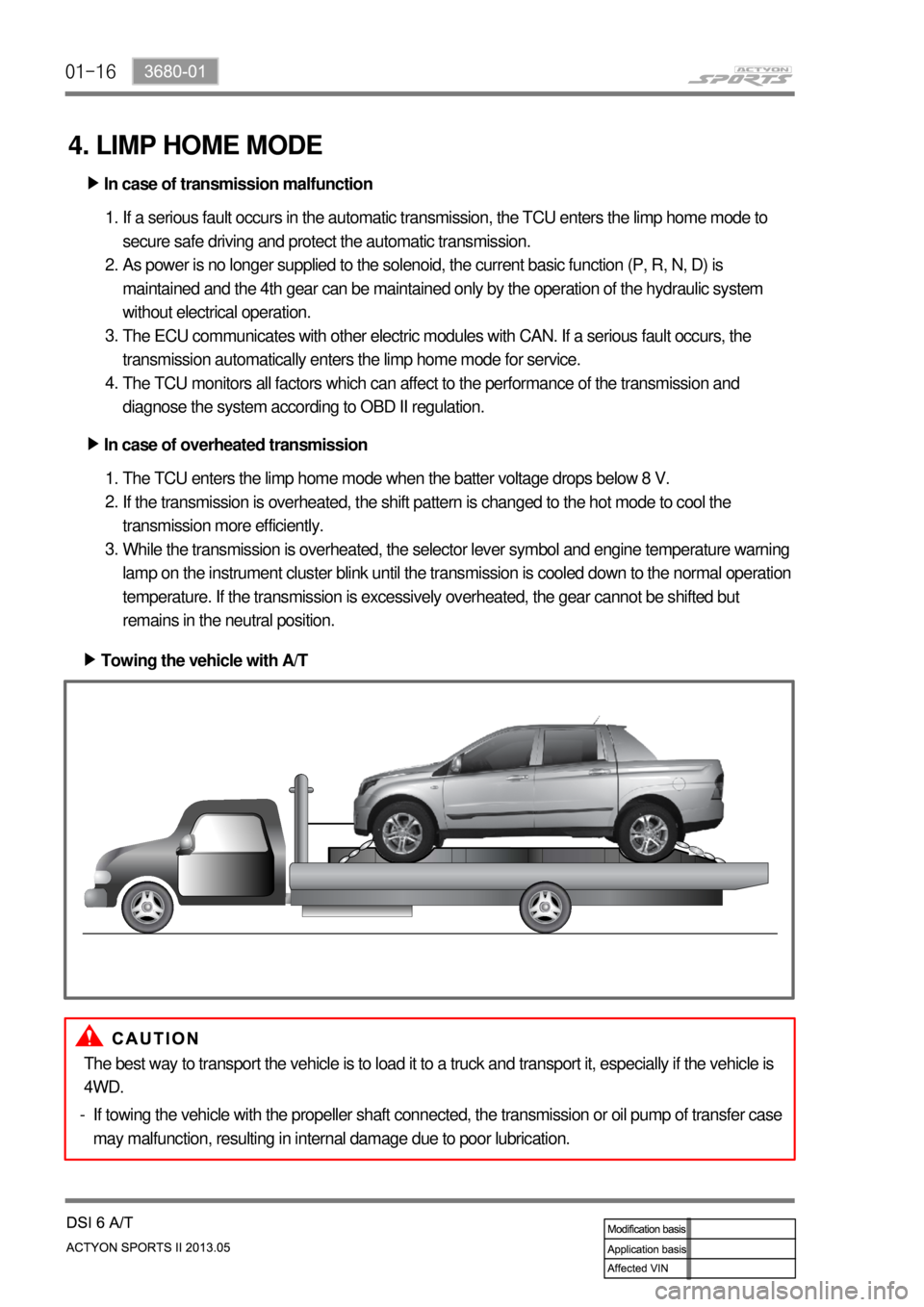
01-16
4. LIMP HOME MODE
In case of transmission malfunction ▶
If a serious fault occurs in the automatic transmission, the TCU enters the limp home mode to
secure safe driving and protect the automatic transmission.
As power is no longer supplied to the solenoid, the current basic function (P, R, N, D) is
maintained and the 4th gear can be maintained only by the operation of the hydraulic system
without electrical operation.
The ECU communicates with other electric modules with CAN. If a serious fault occurs, the
transmission automatically enters the limp home mode for service.
The TCU monitors all factors which can affect to the performance of the transmission and
diagnose the system according to OBD II regulation. 1.
2.
3.
4.
In case of overheated transmission ▶
The TCU enters the limp home mode when the batter voltage drops below 8 V.
If the transmission is overheated, the shift pattern is changed to the hot mode to cool the
transmission more efficiently.
While the transmission is overheated, the selector lever symbol and engine temperature warning
lamp on the instrument cluster blink until the transmission is cooled down to the normal operation
temperature. If the transmission is excessively overheated, the gear cannot be shifted but
remains in the neutral position. 1.
2.
3.
Towing the vehicle with A/T ▶
The best way to transport the vehicle is to load it to a truck and transport it, especially if the vehicle is
4WD.
If towing the vehicle with the propeller shaft connected, the transmission or oil pump of transfer case
may malfunction, resulting in internal damage due to poor lubrication. -
Page 464 of 751

01-18
(2) CAN Input/Output
TCU receives and sends the data among the units through P-CAN communication.
CAN Input/Output Data between Engine ECU and TCU ▶
Page 467 of 751
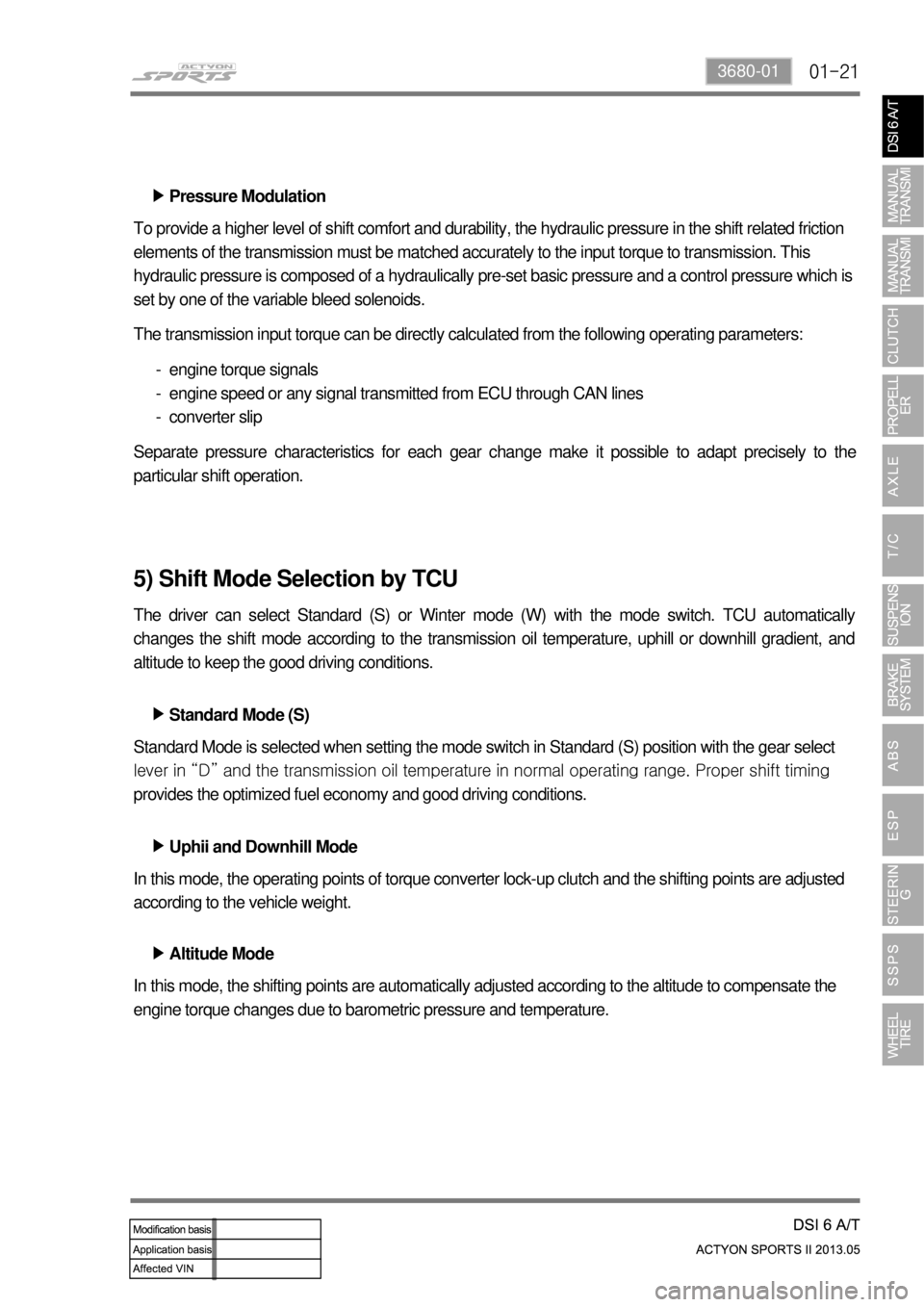
01-213680-01
Pressure Modulation ▶
To provide a higher level of shift comfort and durability, the hydraulic pressure in the shift related friction
elements of the transmission must be matched accurately to the input torque to transmission. This
hydraulic pressure is composed of a hydraulically pre-set basic pressure and a control pressure which is
set by one of the variable bleed solenoids.
The transmission input torque can be directly calculated from the following operating parameters:
engine torque signals
engine speed or any signal transmitted from ECU through CAN lines
converter slip -
-
-
Separate pressure characteristics for each gear change make it possible to adapt precisely to the
particular shift operation.
5) Shift Mode Selection by TCU
The driver can select Standard (S) or Winter mode (W) with the mode switch. TCU automatically
changes the shift mode according to the transmission oil temperature, uphill or downhill gradient, and
altitude to keep the good driving conditions.
Standard Mode (S) ▶
Uphii and Downhill Mode ▶
Altitude Mode ▶ Standard Mode is selected when setting the mode switch in Standard (S) position with the gear select
<0093008c009d008c0099004700900095004702c8006b02c9004700880095008b0047009b008f008c0047009b009900880095009a00940090009a009a00900096009500470096009000930047009b008c00940097008c00990088009b009c0099008c004700
9000950047009500960099009400880093004700960097008c>rating range. Proper shift timing
provides the optimized fuel economy and good driving conditions.
In this mode, the operating points of torque converter lock-up clutch and the shifting points are adjusted
according to the vehicle weight.
In this mode, the shifting points are automatically adjusted according to the altitude to compensate the
engine torque changes due to barometric pressure and temperature.
Page 468 of 751
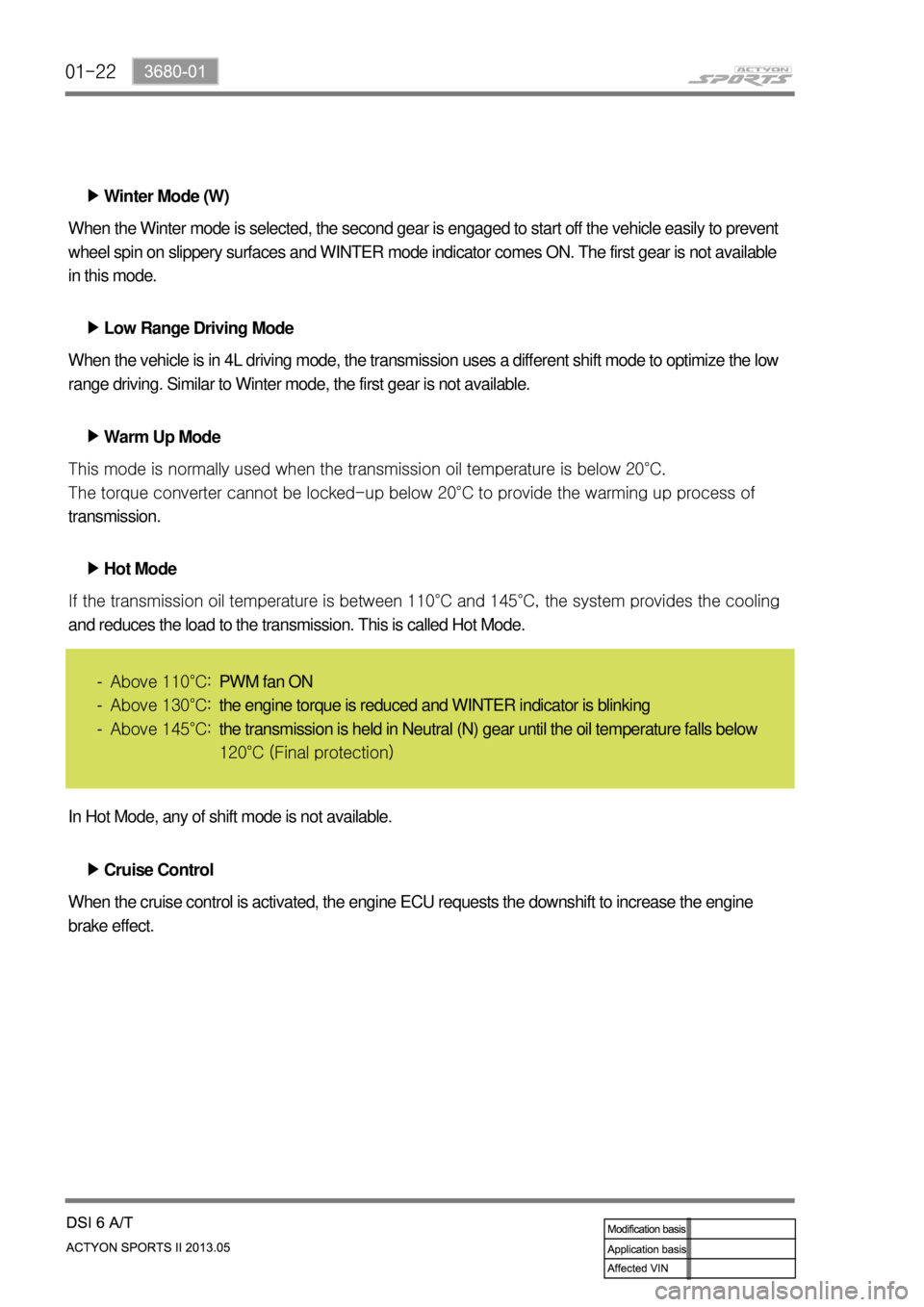
01-22
Winter Mode (W) ▶
Low Range Driving Mode ▶
Warm Up Mode ▶ When the Winter mode is selected, the second gear is engaged to start off the vehicle easily to prevent
wheel spin on slippery surfaces and WINTER mode indicator comes ON. The first gear is not available
in this mode.
When the vehicle is in 4L driving mode, the transmission uses a different shift mode to optimize the low
range driving. Similar to Winter mode, the first gear is not available.
This mode is normally used when the transmission oil temperature is below 20°C.
<007b008f008c0047009b009600990098009c008c0047008a00960095009d008c0099009b008c00990047008a0088009500950096009b00470089008c004700930096008a0092008c008b0054009c009700470089008c00930096009e00470059005700b600
6a0047009b00960047009700990096009d0090008b008c0047>the warming up process of
transmission.
Hot Mode ▶
<0070008d0047009b008f008c0047009b009900880095009a00940090009a009a00900096009500470096009000930047009b008c00940097008c00990088009b009c0099008c00470090009a00470089008c009b009e008c008c0095004700580058005700
b6006a004700880095008b00470058005b005c00b6006a0053> the system provides the cooling
and reduces the load to the transmission. This is called Hot Mode.
Above 110°C:
Above 130°C:
Above 145°C: -
-
-
In Hot Mode, any of shift mode is not available.
Cruise Control ▶
When the cruise control is activated, the engine ECU requests the downshift to increase the engine
brake effect.PWM fan ON
the engine torque is reduced and WINTER indicator is blinking
the transmission is held in Neutral (N) gear until the oil temperature falls below
120°C (Final protection)